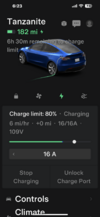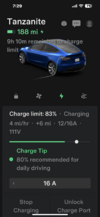Hi, new to the EV world. I have a Y. I have an outlet 5-20 that I am using for charging. I bought the mobile connector with the 5-20 adapter. what I am seeing is that it will start charging at 6 mph at 16/16. About an hour or two later, it will drop to 4mph at 12/16. I set the car to charge to 80%. Is this normal? Not sure if there is anything to do to keep the car charging at 6mph.
at this time, I have no option to install a level 2 outlet as I live in a condo and the outlet I used in located inside my storage that is directly in front of my parking space. If I can maintain the charge rate of 6 mph, it would be sufficient for my driving habit.
please let me know if you have an suggestions. Also, i live in Los Angeles so cold weather is not an issue.
at this time, I have no option to install a level 2 outlet as I live in a condo and the outlet I used in located inside my storage that is directly in front of my parking space. If I can maintain the charge rate of 6 mph, it would be sufficient for my driving habit.
please let me know if you have an suggestions. Also, i live in Los Angeles so cold weather is not an issue.





